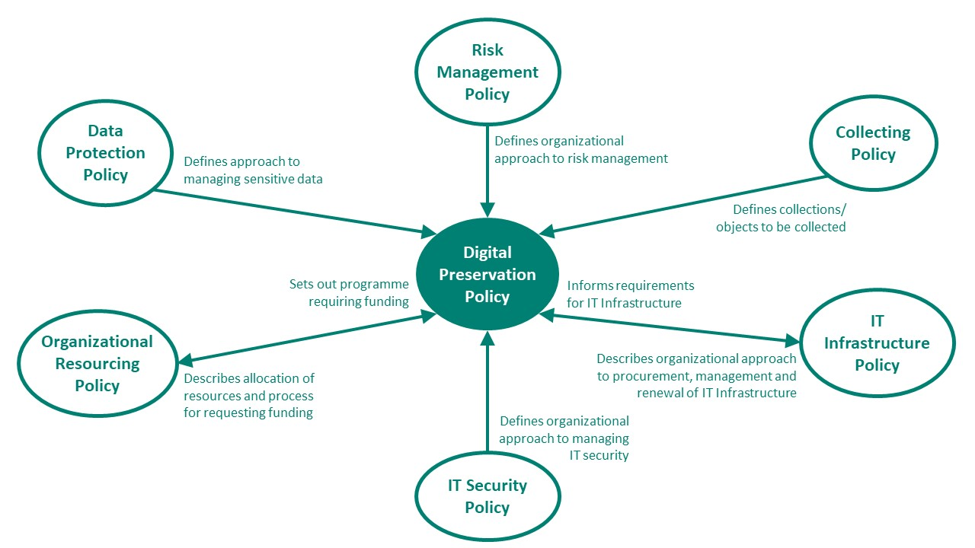This section provides an overview and introduction to preservation policies and this toolkit. Use this to find out more about the toolkit and how to apply it.
What is a Digital Preservation Policy?
A digital preservation policy expresses a set of principles which will guide an organization in the way it approaches preservation activities and responsibilities. A digital preservation policy should relate to organizational objectives and other policies (see diagram below); set out, and be easily understood by, its audience; should identify roles, responsibilities and scope; and should be reviewed regularly in line with other organizational documentation.
While an institutional strategy is typically a long-term plan for the achievement of its vision and goals, many organizations do refer to their policy document as their strategy. Strategy and policy are complementary, but typically try to achieve different things. In reality, the terms are often used interchangeably.
The principles which underpin a policy are high-level guidelines which an organization has agreed upon. Practical day-to-day implementation of principles is generally described in separate, more detailed ‘procedures’ and ‘process’ documentation. The latter go into technical detail and are living documents which are regularly updated.
The purpose of a policy is to support consistent decision making about digital preservation over time (and across the organization). A policy can be either aspirational or describe the current state of play.

Possible relationships between a Digital Preservation Policy and other organizational policies (the policies included are not intended to be comprehensive).
Why do you need a Digital Preservation Policy?
Establishing a policy can be an important early step in developing a new digital preservation capability or formalizing and enhancing a well-established one. A policy does not just guide digital preservation activity, it can also act as a powerful internal advocacy tool.
Some of the benefits of establishing a digital preservation policy are listed below:
-
Provides a mandate for preservation and gives clarity on its scope and aims.
-
Guides staff in their activities relating to digital preservation and informs lower-level guidance and procedures.
-
Supports effective decision making.
-
Ensures digital preservation activity across an organization is consistent and efficient.
-
Helps to raise awareness of digital preservation across an organization.
-
Acts as a driver to establish buy-in from senior management.
-
Solidifies commitment of the institution/organization to deliver digital preservation.
-
Helps support a business case for further digital preservation activities and capital investments, such as a digital repository.
-
A published preservation policy can provide an indication of trustworthiness to those outside an organization.
What if your organization doesn't want a digital preservation policy?
Some organizations are moving away from having an extensive suite of policies to guide and inform different areas of their work. There can be various reasons for this, and if this decision has been made at a high level, you may not be able to influence it. You will therefore need to think creatively about how to achieve the benefits listed above. There may be another type of document you could work on that would suit your organization better; you may be able to incorporate some wording about digital preservation into another document. There may even be benefits to be had from combining principles for digital preservation with other aspects of your organization's work. For example, a combined preservation policy for both physical and digital materials may help ensure that digital preservation is not a siloed activity within your organization; combining digital preservation into IT or records management documents again may be helpful in ensuring digital preservation is better communicated through those departments. Consider what is right for your organizational context. The most important thing to focus on is that the organizational commitment to digital preservation should be documented and flagged up at a high level - whether this is in the form of a document called a 'digital preservation policy' or not.









































































































































